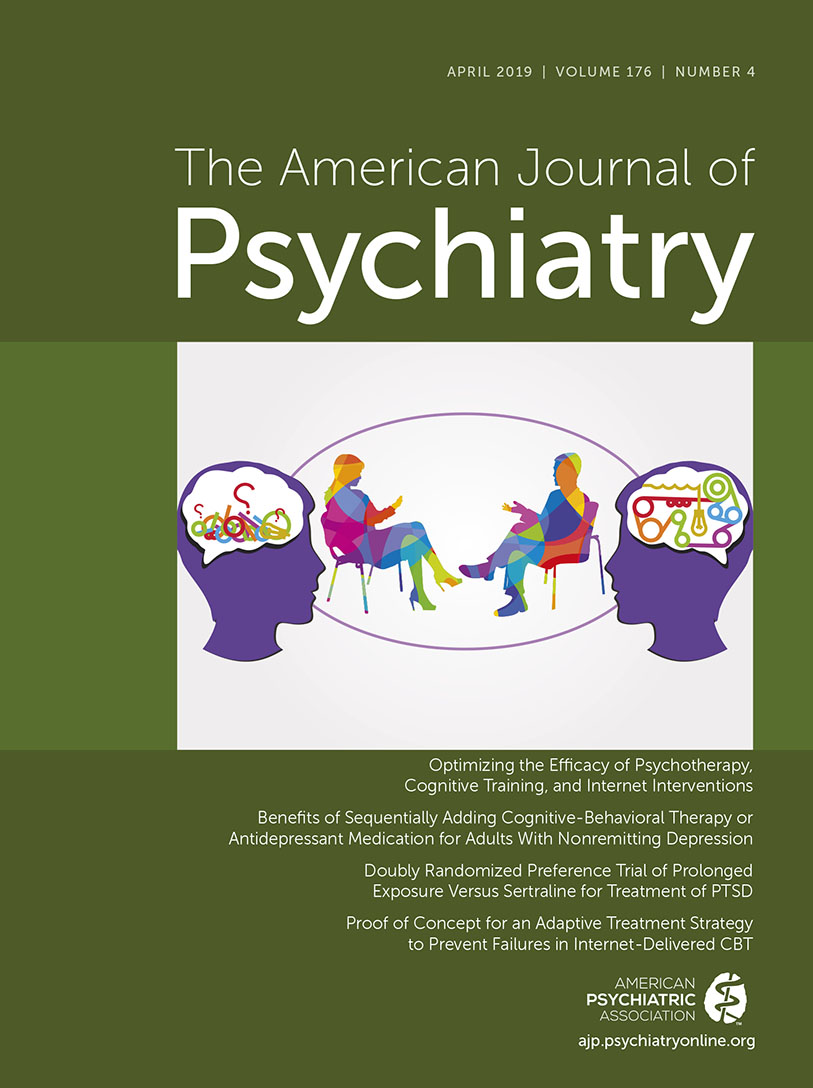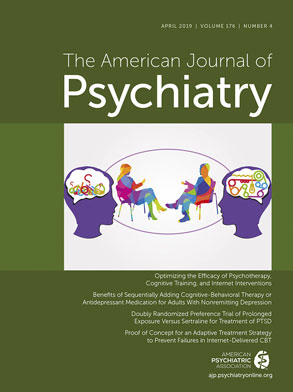Insomnia is a prevalent and distressing issue, with approximately 30% of the population experiencing at least one symptom of insomnia and 6% of the population meeting criteria for an insomnia disorder (
1). Historically, insomnia has been considered a secondary symptom of psychiatric disorders, leading to the unfortunate consequence of psychiatric treatment largely disregarding insomnia as a focus of therapy. However, a more recent large body of prospective studies has demonstrated a bidirectional relationship between insomnia and psychiatric disorders, with evidence supporting insomnia’s contribution to the development of depression, anxiety, alcohol abuse, psychosis, and suicidality (
2,
3). Thus, the value of assessing and treating insomnia in the treatment and possible prevention of mental illness has come to the forefront in psychiatry.
Cognitive-behavioral therapy (CBT) for insomnia has a strong evidence base and is recommended as an initial treatment in those with insomnia alone and also those with comorbid insomnia (
4). More specifically, a meta-analysis examined the efficacy of CBT for insomnia in those with insomnia comorbid with alcohol dependence, depression, posttraumatic stress disorder, or mixed psychiatric diagnoses (
5). Results revealed that CBT for insomnia demonstrated not only medium to large treatment effects on insomnia in these psychiatric patients but also modest treatment effects on their comorbid psychiatric symptoms. Unfortunately, CBT for insomnia is often not easily accessible to patients in need because of factors such as cost and shortage of trained providers (
6).
To increase accessibility, recent efforts have been made to develop and test CBT for insomnia in interactive, Internet-based formats. Results have demonstrated similar treatment outcomes for insomnia using these formats as those using in-person CBT for insomnia (
7,
8). Moreover, Internet-based formats have allowed for larger-scale prospective randomized studies that examine the effect of insomnia treatment on psychiatric symptoms. For example, Freeman et al. (
9) randomly assigned 3,755 U.K. university students who reported significant insomnia symptoms to receive either Internet-based CBT for insomnia or treatment as usual and examined how treatment affected a variety of mental health symptoms. Results revealed that those receiving Internet-based CBT for insomnia not only had significantly less insomnia but also reduced paranoia, hallucinations, depressive symptoms, and anxiety symptoms. These findings are of great importance considering the positive impact a more easily accessed intervention had on both insomnia and psychiatric symptoms. At the same time, the dropout rate of this study (50%), which is similar to that of other Internet-based CBT for insomnia studies, must be considered as a limitation and addressed to optimize care delivery.
Consistent with stepped-care models for the delivery of insomnia treatment (
10), the most efficient use of limited resources comes from matching interventions to patient needs and making the best use of available expertise. In the case of Internet-based CBT for insomnia, early identification of potential treatment failures that can be addressed to alter treatment trajectory is key to making this model of care truly scalable. In this issue of the
Journal, Forsell and colleagues (
11) provide a promising approach to reverse potential treatment failure with Internet-based CBT for insomnia. In this study, 251 participants with insomnia disorder participated in a 9-week Internet-based CBT for insomnia program. During the third week of treatment, using a semi-automated algorithm based on questionnaire measures and engagement in the program, 102 participants were classified as at risk of experiencing treatment failure (Red group), and 149 were classified as not at risk of experiencing treatment failure (Green group). Using a single-blind design, those at risk were then randomly assigned to an adapted treatment (Red-Adapted; N=51) or to continue with regular treatment (Red-Standard; N=51). Results demonstrated that treatment failure could be predicted, in that patients in the Green group had significantly greater reductions in insomnia severity over the course of treatment than those in the Red-Standard group. Treatment adaptation also was efficacious in that the Red-Adapted group reported significantly greater reduction in insomnia severity than the Red-Standard group after randomization. In terms of clinical significance, treatment failure was significantly more likely in the Red-Standard group (64%) than in the Green and Red-Adapted groups (23% and 37%, respectively).
This study has many strengths, including a well-defined sample of individuals with insomnia disorder, the choice of primary and secondary outcome variables that follow current insomnia assessment recommendations, and a low attrition rate. Furthermore, the adapted treatment involved a minimal increase of therapist time per patient (i.e., about 14 minutes weekly), and adaptation examples provided in the online supplement of the article offer reasonable suggestions that remain adherent to a CBT for insomnia model and address common issues in clinical practice with insomnia intervention.
Although the study was well designed, the broad applicability and generalizability of these findings will need to be refined through future lines of inquiry. The authors’ selection of variables for the at-risk classification algorithm has a strong empirical basis, and it demonstrated utility in identifying potential treatment failures in their study. However, the applicability of this algorithm to in-person CBT for insomnia and other Internet-based platforms is not clear. Additionally, the present study does not provide long-term follow-up data and excluded those with an active psychiatric comorbidity. More research providing long-term follow-up with adapted treatment for those with and without comorbid insomnia is needed.
In summary, Forsell and colleagues offer an innovative psychotherapy adaptation strategy in the context of insomnia treatment, demonstrating an ability to identify potential therapeutic failures in Internet-delivered care, with subsequent adjustment to treatment to achieve improved outcomes. Further key research directions include continuing to develop effective and feasible algorithms to identify potential treatment failures with both Internet-based and in-person treatment formats, and improving short- and long-term outcomes for a variety of populations. Translating these findings into clinical practice also will require that these lines of inquiry be advanced with an appreciation for evolving and complex access limitations (insurance, financial, regulatory, etc.) to Internet-based psychotherapy programs for insomnia. These future directions and considerations apply not only to advancing innovative psychotherapy practices for insomnia but also Internet-delivered psychotherapy for mental illness more broadly.

